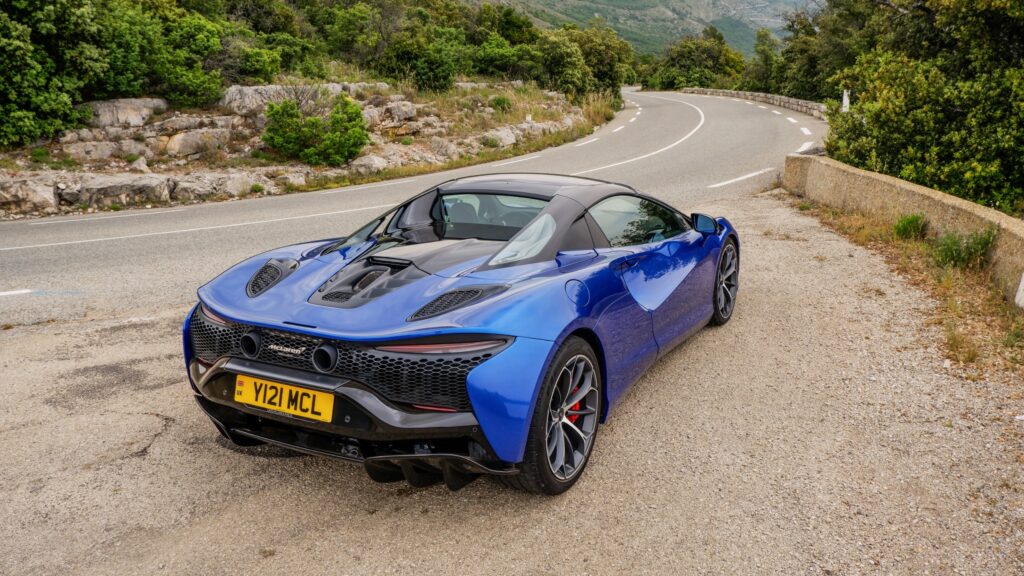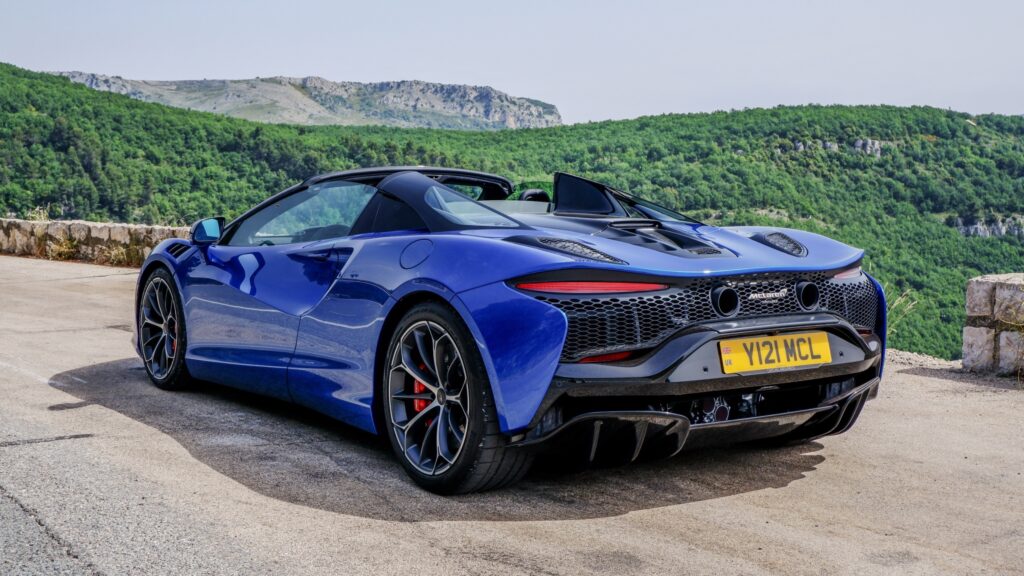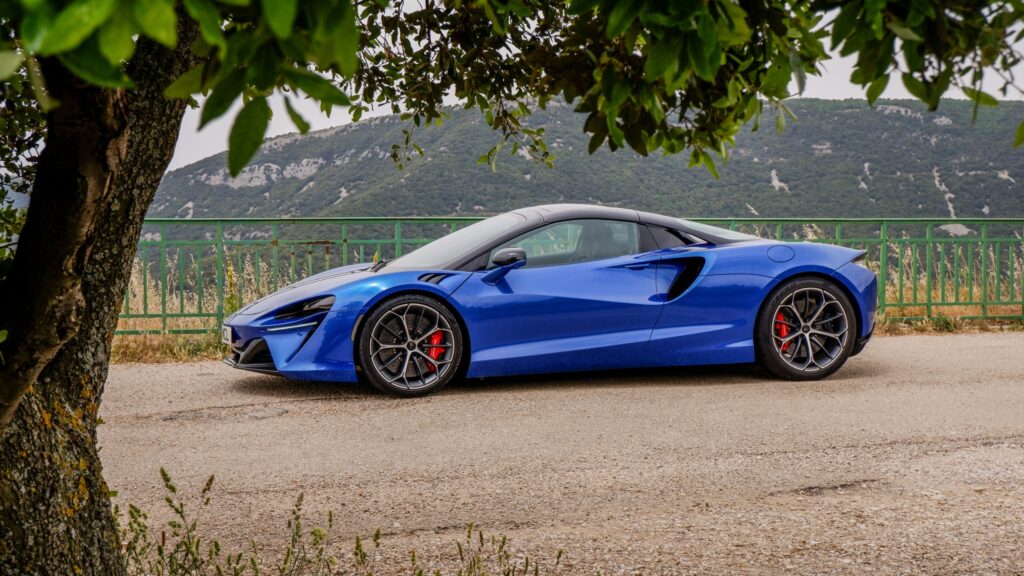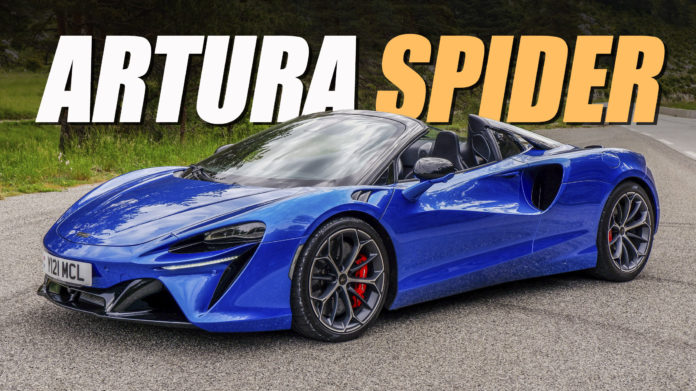Two years after unveiling the all-new Artura Coupe, McLaren has launched the Artura Spider, expanding its range of electrified entry-level supercars. In addition to the allure of a topless bodystyle, the Artura Spider introduces a range of performance and technological upgrades also adopted by the Coupe for the 2025 model year.
McLaren recently invited us to Cote d’Azur, where we tested their latest model on the winding mountain roads of southern France. The journey culminated in a grand finale – commanding attention on the supercar-saturated streets of Monaco.
Driven: The McLaren Artura Gives You 671 Reasons To Love Its Plug-In Hybrid Powertrain
Drop-top supercars typically experience weight gain compared to their fixed-top counterparts due to necessary reinforcements compensating for the rigidity lost without a roof. In the case of the Artura Spider, this difference is only 136 pounds (62 kg)—less than the weight of an additional passenger.
McLaren emphasizes the importance of low weight in its vehicles in the era of electrification, highlighting that the Artura Spider is 182 lbs (83 kg) lighter than its closest rival—the more expensive Ferrari 296 GTS.
Quick Facts
Eye-Catching Exterior
Visually, the Artura Spider looks sexy from almost every angle, thanks to the mid-engined proportions and sculpted body panels. These panels are crafted using an aluminum hot-forming technique, enabling designers to achieve intricate shapes while minimizing panel gaps.
The Spider’s rear deck has been completely redesigned compared to the Coupe, with a new tonneau cover made of carbon fiber. The highlight is the transparent flying buttresses, bringing a slight improvement in over-the-shoulder visibility and adding to the supercar’s charisma.
Thanks to its single-piece roof, the Artura Spider converts from hardtop to convertible in just 11 seconds, operable at speeds up to 50 km/h (21 mph). Additionally, individually retractable rear glass allows occupants to savor the engine’s growling sound even with the roof up.
A complex arrangement of inlets and vents channel streams of hot and cold air to the Artura’s tail for optimum aerothermal efficiency. McLaren says that the compact powertrain and the ultra-rigid carbon tub of the Coupe were developed with the Spider in mind right from the start, so there was no need for extra bracing to support the drop-top bodystyle.
Like the coupe, the side intakes may evoke thoughts of the Lotus Emira, but the overall shape remains distinctly McLaren, with styling cues shared from previous supercars and hypercars such as the flagship P1. In our press car, the Volcano Blue color and Star forged wheels stand out more favorably compared to the McLaren Orange with Dynamo forged wheels seen on other models.
Modern And Driver-Focused Interior
Opening the butterfly doors of the Artura Spider, you come across a very low seating position, with the carbon tub wrapped around you. Nevertheless, visibility is excellent, and the car feels surprisingly compact.
Despite its low height of 1,193 mm (47.0 inches), there is ample headroom for most individuals, accommodating the use of helmets. Getting in and out of the car is also easier compared to typical supercars.
The standard single-piece Clubsport buckets feature a single electric motor for simultaneous height adjustment and seatback inclination, meeting the needs of most users. The optional comfort seats may be preferable for longer journeys, but I personally had no issues with the thinner and lighter Clubsport seats after driving for 4-5 hours.
Practicality was not the utmost priority for the Artura Spider, with the 5.7 cubic feet (160 lt) frunk being smaller than the boot of a city car, and limited in-cabin storage with the notable omission of a glovebox. Still, you’ll find a narrow cubby with USB outlets, a single cup holder, a secure smartphone holder with wireless charging, and average-sized door bins that keep items from falling off when the doors swing upwards.
At first, I was slightly disappointed by the absence of physical controls on the Artura’s center console, which is dominated by an 8-inch infotainment touchscreen. The unit features thick bezels and a convenient rotating volume knob that also serves as a home button.
However, after a few moments of exploration, I found it excels in simplicity and responsiveness. Most functions are just a click or touch away, and I never felt lost in complex sub-menus.
Having said that, it it would be preferable if McLaren had included physical knobs for the climate controls, which are always visible but touch-sensitive, enabling drivers to adjust them without diverting their attention from the road. Another area for improvement is the display’s susceptibility to fingerprints, and the absence of Android Auto compatibility (only offering wired Apple CarPlay).
McLaren’s choice to omit buttons from the steering wheel requires navigating the media menu each time you wish to change a song or radio station. This can be frustrating, especially without a passenger to manage DJ duties.
The 10-inch digital instrument cluster that moves with the steering column has sharp graphics, but the rear-view camera function is often hindered by the spokes of the steering wheel blocking the view while turning and reversing. Thankfully, there is a bird-eye view of the supercar on the infotainment screen, making it easier to park.
More: McLaren Teases New Design Language And Wraparound Cockpits
Our tester featured the optional Performance interior that was bathed in Alcantara upholstery, improving the perceived quality of the cabin. The only downside we noticed in this particular example was the squeaky plastics on the air vents which could be better in a vehicle of this caliber.
As in the Artura Coupe, the single-piece roof of the Spider is optionally available with an electrochromic glass, blocking the sunlight at a touch of a button. However, unless the sun is burning, you’ll probably find yourself driving the Artura Spider as it was meant to be driven – with the roof down.
Driving Experience
Before hitting the road in a McLaren Artura, all you have to do in terms of homework is check out the two toggle switches mounted on the corners of the instrument cluster. These are always at your fingertips, giving you easy access to the different modes for the powertrain (EV, Comfort, Sport, Track) and the chassis (Comfort, Sport, Track).
If you select the EV mode on startup, you experience a different side of the Artura, with only 94 hp (70 kW / 95 PS) on tap and a completely silent drive. This zero-emission mode was designed for moving in and out of your garage without waking up the neighbors, or during stop and go traffic in urban environments.
Despite what the numbers suggest, the tiny electric motor mounted inside the 8-speed SSG automatic gearbox has adequate pick-up at speeds of up to 30 mph (50 km/h), making it suitable for city driving. The small 7.4 kWh battery offers up to 21 miles (33 km) of zero-emission range, but no one was going to use the Artura primarily as an EV anyway. This is a McLaren, after all, not a grocery getter with an eco-conscience.
If you haven’t used or warmed up the engine at all since startup, the switch from EV to ICE can take up to 42 seconds in US-spec Arturas (the whole process is a lot faster for other markets). This may sound like a minor annoyance, but in reality, the switch happens immediately, with the V6 ready to step in at all times.
Notably, the Comfort mode uses the hybrid system in a more efficient manner, but still gives you access to the full 690 hp (515 kW / 700 PS) of power.

At full throttle, the plug-in hybrid supercar lives up to its impressive specs, propelling the Artura Spider to triple-digit speeds effortlessly. Yet, when driven at lower revs, the power delivery remains smooth and linear, ensuring the car feels approachable in everyday driving situations.
Interestingly, the basic performance figures are identical to the Coupe, with the Spider completing the 0-62 mph (0-100 km/h) sprint in 3 seconds flat, and reaching an electronically limited top speed of 205 mph (330 km/h). The only noticeable difference—on paper—is the 0-124 mph (0-200 km/h) run, achieved in 8.4 seconds, just 0.1 seconds slower than the MY 2025 coupe.
In reality, while some performance EVs deliver faster acceleration figures, they can’t compete with the dramatic experience of driving the Artura Spider. At the same time, the electric motor limits any lag from the ICE, using battery in favor of performance.
The sound of McLaren’s twin-turbo 3.0-liter V6 is exhilarating, especially with the optional sports exhaust fitted to our car, a popular choice among Artura buyers. Apart from producing a more robust exterior sound, genuine exhaust notes are channeled into the cabin through dedicated slits behind the seats. These features are active only in Sport and Track modes, ensuring the ultra-silent EV and refined Comfort modes remain unchanged.
The Sport settings for the chassis and powertrain proved ideal for spirited driving on the winding roads of Route Napoleon, allowing us to fully appreciate the impeccable driving dynamics of the Artura.
Track mode spices things up even further, especially when you dial down the electronic aids using a dedicated button, which also offers the option to disable them entirely (although this should be reserved for McLaren test drivers on closed circuits).
Impressively, even when exiting corners at full throttle, the supercar maintains its line, demonstrating how far we’ve come in terms of electronics in extremely powerful rear-wheel drive vehicles.
The rigidity of the MCLA (McLaren Carbon Lightweight Architecture) underpinnings can be felt from the first moments behind the wheel, with the Artura Spider feeling exceptionally composed on B-roads. At the same time, the steering is light but sharp as a knife, offering greater responsiveness than a high-end driving simulator.
While the suspension is firm, the ride is surprisingly refined, particularly in Comfort mode. This setting optimizes the adaptive dampers for a smoother experience on highways, albeit with a slight compromise in steering sharpness, reducing the need for constant adjustments.
The massive carbon ceramic brakes with aluminum calipers deliver immense stopping power and prove resilient under pressure. However, in daily driving scenarios, the brake pedal demands more force than anticipated to provide initial bite.
As intimidating as it may seem, maneuvering the Artura Spider through Monaco’s narrow roads proved surprisingly effortless. Despite its generous width of 1,913 mm (75.3 inches)—similar to a BMW X3—it fits comfortably in most spaces. Additionally, the standard nose-lift function in the US swiftly handles speed bumps in a matter of seconds.
We also tested the Artura Spider on the highway, only to admire the NVH levels of the supercar. The clever aerodynamics allow you to drive with the top down at speeds of 68 mph (110 km/h) and still enjoy comfortable conversations with the passenger while experiencing minimum air disturbance.
Furthermore, the Artura Spider’s height difference with large SUVs/trucks in traffic posed no issue, thanks to excellent visibility and its standout presence that ensures it’s always noticed by other road users.
Upgrades For The 2025 MY
The 2025 McLaren Artura Spider introduces several upgrades compared to the original Coupe. These enhancements, excluding the retractable roof and redesigned rear deck, are also implemented in the 2025 Artura Coupe. Additionally, current owners of the supercar can enjoy a complimentary software upgrade that unlocks an additional 19 hp (15 kW / 20 PS) of power.
Beyond the power bump, the 2025 Artura boasts a suite of performance upgrades: new engine mounts for sharper handling, an optimized electrical architecture for peak efficiency, and a revised suspension with lightning-fast responses (up to 90% quicker).
McLaren also tweaked the transmission calibration with a pre-fill feature, resulting in 25% faster gear changes. Upgraded brake cooling ducts ensure fade-resistant stopping power, while McLaren added a new “spinning wheel pull-away feature”, which is perfect for prolonged smoking burn-outs in the track.

Pricing and Rivals
The 2025 McLaren Artura Spider starts at $273,800 in the US, marking a $24,700 increase over the equivalent Artura Coupe. Our test car featured an impressive $57,900 in optional extras, including alloy wheels, a sport exhaust, a premium 12-speaker Bowers & Wilkins audio system, comprehensive ADAS options, and an Alcantara-upholstered cabin. This brought the total ‘as-seen’ price to over $331,700 before on-road costs.
More: Ferrari 296 GTS Hybrid Is An 819-HP Tanning Machine
In terms of competition, the only electrified rival to the McLaren Artura Spider is the Ferrari 296 GTS, which also features a plug-in hybrid V6 powertrain. However, its higher price tag of $371,139 places it closer to the the larger McLaren 750S priced at $345,000.
Among drop-top supercar offerings in a similar price range, the Maserati MC20 at $276,995 stands out, especially since the Lamborghini Huracan Spyder has been discontinued. Another potential competitor could be the upcoming Lamborghini Temerario, debuting later this year with a plug-in hybrid V8, depending largely on its pricing.
Overall, while the McLaren Artura Spider is certainly not inexpensive, when compared to its rivals, a compelling case can be made for its value proposition. Thrill-seeking drivers yearning for the visceral experience of a mid-engine supercar, especially those who hold the McLaren name in high regard for its motorsport pedigree, will find the Artura Spider a worthy contender.

Verdict
The McLaren Artura Spider is a desirable exotic, adding the extra benefit of the roofless bodystyle to an already compelling package. Its plug-in hybrid twin-turbo V6 powertrain delivers impressive sound and performance, mirroring the coupe’s capabilities thanks to the lightweight design of the convertible. Moreover, the enhancements for the 2025 model year elevate the Artura’s on-road agility even further.
While having 690 hp (515 kW / 700 PS) on tap sounds exciting, the greatest strength of the Artura is the exceptional driving dynamics. The combination of McLaren’s ultra-rigid carbon-fiber tub, the sophisticated chassis setup, and the advanced electronics take the driving experience to another level.
More importantly, despite the intimidating power figures, the Artura Spider is friendly and easy to set up, allowing drivers with all kinds of experience to have plenty of fun behind the wheel.
The McLaren Artura Spider reigns supreme as the (somewhat) affordable option in the entry-level supercar arena – at least until its flamboyant, fire-breathing Lamborghini Temerario rival roars onto the scene. But a word to the wise: go easy on those tempting extras. They can quickly inflate the price tag to stratospheric levels, pushing you dangerously close to McLaren 750S Spider territory. In other words, exclusivity always has a price, and just like any other premium offering these days, the Artura Spider loves to nickel and dime you for it.
Photos and Videos: Thanos Pappas for CarScoops

